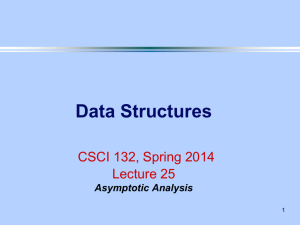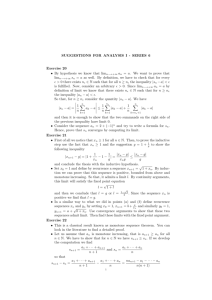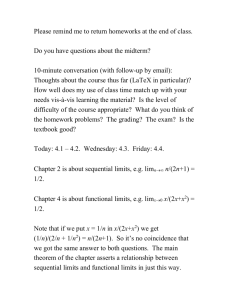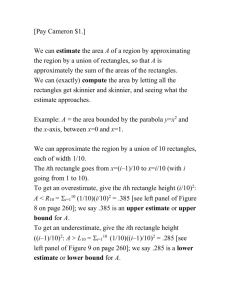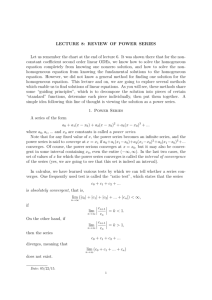Homework 2 Solutions The exercises are from Foundations of
advertisement
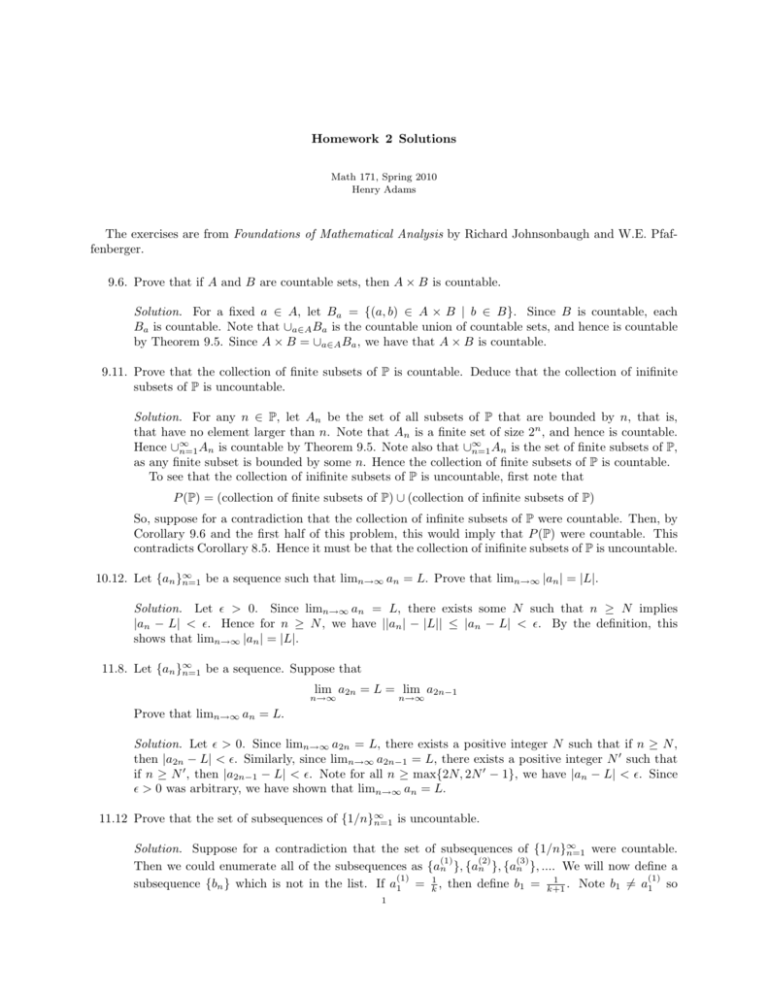
Homework 2 Solutions
Math 171, Spring 2010
Henry Adams
The exercises are from Foundations of Mathematical Analysis by Richard Johnsonbaugh and W.E. Pfaffenberger.
9.6. Prove that if A and B are countable sets, then A × B is countable.
Solution. For a fixed a ∈ A, let Ba = {(a, b) ∈ A × B | b ∈ B}. Since B is countable, each
Ba is countable. Note that ∪a∈A Ba is the countable union of countable sets, and hence is countable
by Theorem 9.5. Since A × B = ∪a∈A Ba , we have that A × B is countable.
9.11. Prove that the collection of finite subsets of P is countable. Deduce that the collection of inifinite
subsets of P is uncountable.
Solution. For any n ∈ P, let An be the set of all subsets of P that are bounded by n, that is,
that have no element larger than n. Note that An is a finite set of size 2n , and hence is countable.
∞
Hence ∪∞
n=1 An is countable by Theorem 9.5. Note also that ∪n=1 An is the set of finite subsets of P,
as any finite subset is bounded by some n. Hence the collection of finite subsets of P is countable.
To see that the collection of inifinite subsets of P is uncountable, first note that
P (P) = (collection of finite subsets of P) ∪ (collection of infinite subsets of P)
So, suppose for a contradiction that the collection of infinite subsets of P were countable. Then, by
Corollary 9.6 and the first half of this problem, this would imply that P (P) were countable. This
contradicts Corollary 8.5. Hence it must be that the collection of inifinite subsets of P is uncountable.
10.12. Let {an }∞
n=1 be a sequence such that limn→∞ an = L. Prove that limn→∞ |an | = |L|.
Solution. Let > 0. Since limn→∞ an = L, there exists some N such that n ≥ N implies
|an − L| < . Hence for n ≥ N , we have ||an | − |L|| ≤ |an − L| < . By the definition, this
shows that limn→∞ |an | = |L|.
11.8. Let {an }∞
n=1 be a sequence. Suppose that
lim a2n = L = lim a2n−1
n→∞
n→∞
Prove that limn→∞ an = L.
Solution. Let > 0. Since limn→∞ a2n = L, there exists a positive integer N such that if n ≥ N ,
then |a2n − L| < . Similarly, since limn→∞ a2n−1 = L, there exists a positive integer N 0 such that
if n ≥ N 0 , then |a2n−1 − L| < . Note for all n ≥ max{2N, 2N 0 − 1}, we have |an − L| < . Since
> 0 was arbitrary, we have shown that limn→∞ an = L.
11.12 Prove that the set of subsequences of {1/n}∞
n=1 is uncountable.
Solution. Suppose for a contradiction that the set of subsequences of {1/n}∞
n=1 were countable.
(1)
(2)
(3)
Then we could enumerate all of the subsequences as {an }, {an }, {an }, .... We will now define a
(1)
(1)
1
. Note b1 6= a1 so
subsequence {bn } which is not in the list. If a1 = k1 , then define b1 = k+1
1
(n)
{bn } 6= {a(1) }. Inductively, if an
=
1
k
and bn−1 =
1
k0 ,
1
max{k,k0 }+1 . Note that
(n)
bn 6= an so {bn } 6= {a(n) }
then define bn =
bn < bn−1 and so {bn } is indeed a subsequence of {1/n}. Note also that
for all n. So {bn } is a subsequence of {1/n} that is not in our list, a contradiction. Hence the set of
subsequences of {1/n}∞
n=1 is uncountable.
This is an example of a diagonalization argument, as is Example 8.3.
12.4 Find limn→∞
√
n+1−
√
n.
Solution. Note
√
√
√
√
√
√
n+1+ n
1
1
n + 1 − n = ( n + 1 − n) √
√ =√
√ ≤√
n
n+1+ n
n+1+ n
√
√
Since limn→∞ √1n = 0, this means that limn→∞ n + 1 − n = 0.
12.7 If limn→∞ (an+1 /an ) = 0, find limn→∞ an .
Solution. Since limn→∞ (an+1 /an ) = 0, then there exists some N such that for all n ≥ N , we have
N
|an+1 /an | < 21 . Hence for m positive, |aN +m | < | a2m
|. Note that limm→∞ 21m = 0, either by TheN
orem 16.3 or the example on the bottom of page 47. Hence limm→∞ | a2m
| = 0, and so limn→∞ an = 0.
13.1 Prove that if {an } and {bn } are bounded sequences and c is a real number, then {can }, {an + bn },
and {an bn } are bounded sequences.
Solution. Since {an } and {bn } are bounded sequences, there exist numbers M and M 0 such that
|an | ≤ M and |bn | ≤ M 0 for all n.
Given c ∈ R, we have |can | = |c||an | ≤ |c|M for all n, so |c|M is a bound for {can } and so {can }
is bounded.
Note |an + bn | ≤ |an | + |bn | ≤ M + M 0 for all n, so M + M 0 is a bound for {an + bn } and so
{an + bn } is bounded.
Note |an bn | ≤ |an ||bn | ≤ M M 0 for all n, so M M 0 is a bound for {an bn } and so {an bn } is bounded.
13.3 Give an example of sequences {an } and {bn } such that {an } is bounded and {bn } is convergent, but
{an + bn } and {an bn } are divergent.
Solution. Let
(
0
an =
1
n even
n odd
Let bn = 1 for all n. Then {an } is bounded by 1 and {bn } is converges to 1. However,
(
1 n even
an + bn =
2 n odd
so {an + bn } is divergent and
(
an bn =
0
1
n even
n odd
so {an bn } is divergent.
15.4 Let {an } and {bn } be sequences such that limn→∞ an = ∞ = limn→∞ bn . Prove that limn→∞ an bn =
∞.
Solution. Let M be a real number. Since limn→∞ an = ∞, there exists a positive integer N
such that if n ≥ N then an > 1. Since limn→∞ bn = ∞, there exists a positive integer N 0 such that
2
if n ≥ N 0 then bn > M . Hence, if n ≥ max{N, N 0 }, then an bn > 1 · M = M . This shows that
limn→∞ an bn = ∞.
16.5 Find the following limits.
2
Solution. (a) limn→∞ (1 + n12 )n
2
Note the sequence (1 + n12 )n is a subsequence of (1 + n1 )n , which has limit e. Hence limn→∞ (1 +
2
1 n
= e by Theorem 11.2.
n2 )
1
(b) limn→∞ (1 + n+1
)n
1
Note (1 + n+1 )n = (1 +
lim (1 +
n→∞
1
n+1
/(1
n+1 )
+
1
n+1 ).
By Theorem 12.9,
1 n
1 n+1
1
) = lim (1 +
)
/ lim (1 +
) = e/1 = e
n→∞
n→∞
n+1
n+1
n+1
(c) limn→∞ (1 + n1 )n+1
Note (1 + n1 )n+1 = (1 + n1 )n (1 + n1 ). By Theorem 12.6,
lim (1 +
n→∞
1
1
1 n+1
)
= lim (1 + )n lim (1 + ) = e · 1 = e
n→∞
n
n n→∞
n
(d) limn→∞ (1 + n12 )n
2
By Theorem 16.6, we know that 1 ≤ (1 + n12 )n ≤ e for all n positive. Taking n-th roots, we get
1 ≤ (1 + n12 )n ≤ e1/n . Note limn→∞ e1/n = 1 by Theorem 16.4. Hence by Theorem 14.3, the Squeeze
Theorem, we have limn→∞ (1 + n12 )n = 1.
2
(e) limn→∞ (1 + n1 )n
Since limn→∞ (1 + n1 )n = e > 2, there exists some N such that (1 + n1 )n > 2 for all n ≥ N . Hence
2
2
(1 + n1 )n > 2n for all n ≥ N . Since limn→∞ 2n = ∞, this means that limn→∞ (1 + n1 )n = ∞.
1 n
)
(f) limn→∞ (1 + 2n
1 n
Note (1 + 2n ) = ((1 +
lim (1 +
n→∞
1 2n 1/2
.
2n ) )
Hence
√
1 2n 1/2
1 2n 1/2
1 n
) = lim ((1 +
) )
= ( lim (1 +
) )
= e1/2 = e
n→∞
n→∞
2n
2n
2n
where the second equality is from Exercise 12.6, or from the fact that the square root is a continuous
function.
16.13 Let {an } be any sequence of real numbers such that limn→∞ nan = 0. Prove that limn→∞ (1 +
an )n = e.
1
n
+
n
1 n
1
Solution. First, note that for a > 0, (1 + na )n = (1 + n/a
) = ((1 + n/a
) a )a . Also note that
n
1
1
limn→∞ (1 + n/a ) a = e since x → (1 + x )x is an increasing function on (0, ∞). Hence
lim (1 +
n→∞
a n
1 n a
) = lim ((1 +
) a ) = ea
n→∞
n
n/a
by Exercise 17.4, which is an extension of Corollary 12.7 to real numbers.
So, given > 0, pick 1 > δ > 0 sufficiently small such that e1+δ < e + and e1−δ > e − .
n
1+δ
n
1−δ
Since limn→∞ nan = 0, since limn→∞ (1 + 1+δ
, and since limn→∞ (1 + 1−δ
,
n ) = e
n ) = e
1+δ n
1+δ
there exists an N such that n ≥ N implies |nan | < δ, implies (1 + n ) < e
+ , and implies
3
(1 +
1−δ n
n )
> e1−δ − . Then n ≥ N implies
(1 +
1
1 + nan n
1+δ n
+ an )n = (1 +
) < (1 +
) < e1+δ + < e + 2
n
n
n
and
1
1 + nan n
1−δ n
+ an )n = (1 +
) > (1 +
) > e1−δ − > e − 2
n
n
n
Hence limn→∞ (1 + n1 + an )n = e.
(1 +
16.15 Let a1 > 1. Let an+1 = 2 − 1/an for n = 1, 2, .... Prove that {an } is a bounded monotone sequence
and find the limit.
Solution. Note if an > 1, then 1/an < 1 so an+1 = 2 − 1/an > 2 − 1 = 1. Hence by induction on n,
we have an > 1 for all n. So {an } is bounded below by 1.
Note a2n − 2an + 1 = (an − 1)2 ≥ 0 implies a2n ≥ 2an − 1 implies an ≥ 2 − 1/an = an+1 as an
is positive for all n. Hence {an } is a decreasing sequence. So {an } is bounded above by a1 , and so
{an } is a bounded sequence.
By Theorem 16.2, {an } has a limit; call it L. We have
L = lim an = lim an+1 = lim (2 − 1/an ) = 2 − 1/L
n→∞
n→∞
n→∞
by the results of Chapter 12. We solve for L to see L = 1.
18.1. Show (by example) that “bounded” cannot be omitted from the hypotheses of the Bolzano-Weierstrass
theorem.
Solution. Consider the increasing sequence (un ) given by un = n. A subsequence of (un ) is of
the form (uf (n) ) where f : N → N is a strictly increasing function. No subsequence of (un ) is
bounded, since given any M , we have
uf (M +1) ≥ uM +1 = M + 1 > M.
So any subsequence of (un ) is monotone but not bounded, and so by Theorem 16.2, any subsequence
of (un ) is not convergent.
18.5. Let {an } be a sequence such that for some > 0, |an − am | ≥ for all n 6= m. Prove that {an } has
no convergent subsequence.
Solution. Because any subsequence of {an } has the same property (above) as {an }, it suffices
to prove that {an } does not converge (for then any subsequence of {an } will not converge by the
same proof).
Suppose for a contradiction that {an } has a limit L. Then by the definition of a limit, there exists
some integer N such that for all n ≥ N , |an − L| < 2 . In particular, we have |aN − L| < 2 . However,
this implies that
|aN +1 − L| ≥ |aN +1 − aN | − |aN − L| > − = ,
2
2
where we used the triangle inequality. This is a contradiction, and so {an } cannot converge.
Note: another easy way to see that {an } does not converge would be to show that the sequence
{an } is not Cauchy and then use Theorem 19.3.
4

